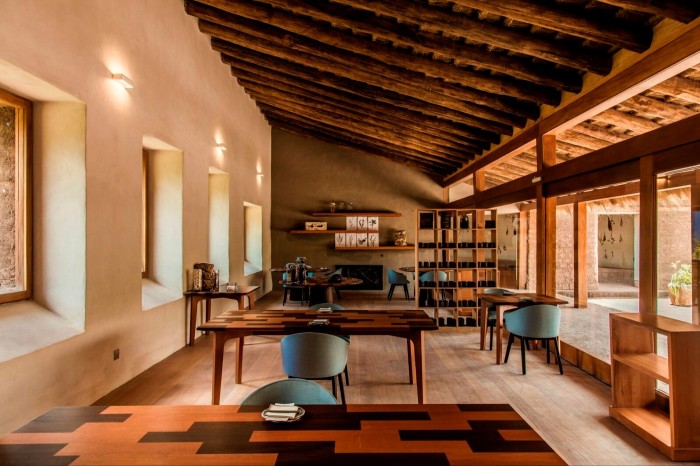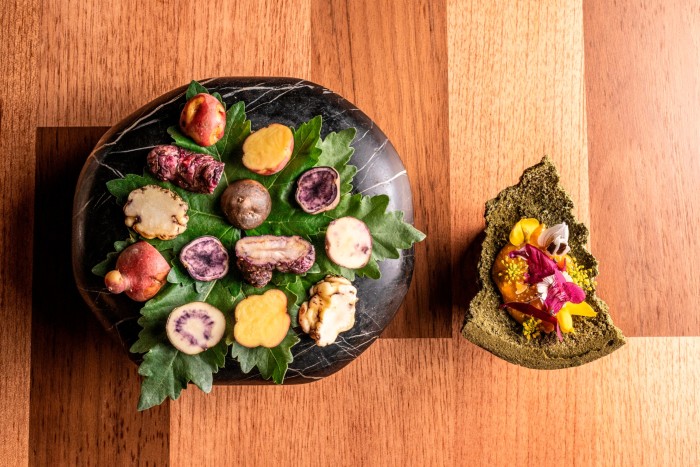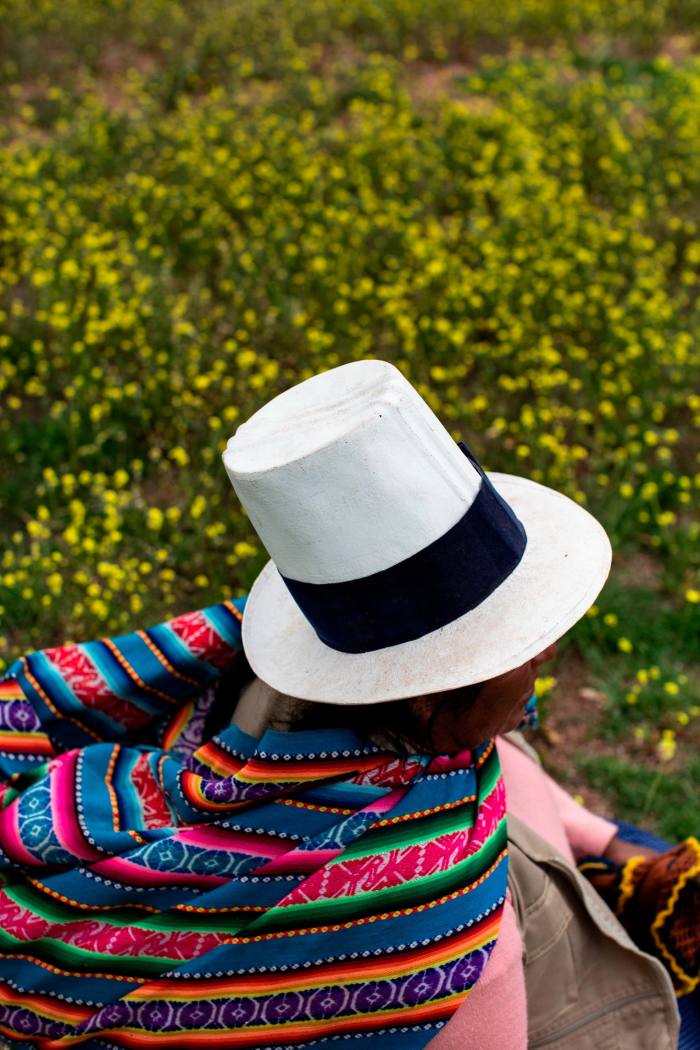
As I sit down to lunch my head is in a spin. It’s a dizziness brought on partly by altitude sickness, partly by a number of pre-lunch cocktails, and partly by sheer excitement at having made it to one of the summits of global gastronomy.
Last month, Central, the Lima restaurant of Peruvian chef Virgilio Martínez took the number one spot in the annual San Pellegrino/Acqua Panna “The World’s 50 Best Restaurants” list, in recognition of “a menu that celebrates the unique biodiversity of the country’s indigenous ingredients”. I’m at Mil Centro, Martínez’s outpost halfway between Cusco and Machu Picchu, 3,568m up in the Peruvian Andes — not just a restaurant, but the fieldwork headquarters for his research into those ingredients.
Into the rustic-beamed, uncluttered interior pours a piercingly bright high-mountain light. The window nearest my table frames a verdant world of pasture and potato fields with, at the back of the picture, a jagged ridge of cordillera glittering silver-white with permanent snows.
The location is significant: just out of view lie the remains of an Inca site where circular terraces are carved out of the earth like a vast quarry. Archaeologists now believe the earthworks at Moray, built sometime between the 12th and 14th centuries, formed a kind of Inca research station where agronomists tested crops for their performance in different soils and temperatures.


If in the last decade Peru has gate-crashed the inner sanctum of the world’s most celebrated cuisines, this is in large part thanks to Martínez (though respect is also due to Gastón Acurio, the Paris-trained godfather of the new Peruvian cooking and Mitsuharu Tsumura, grandmaster of Japanese-Peruvian “Nikkei” style). As a chef Martínez has made it his life’s work to put Peru’s wealth of traditional ingredients centre-stage — and not just in bit-parts, but in starring roles that celebrate their often extraordinary qualities of texture and taste. He and his permanent team of ethno-botanists, anthropologists and taxonomists have built up an archive of products and cultural uses hailing from the Amazon basin to the Andes and the Pacific coastal strip. To a European palate many of these native ingredients — among them tubers, herbs and grains, fruits and berries, guinea pigs and giant freshwater fish — offer the thrill of unfamiliarity, like seeing an unimagined colour for the very first time.
The room at Mil is quiet but buzzes with concentration. I hear French, Australian, American voices — the trip here being a foodie pilgrimage that, if it’s not quite on the level of Sweden’s late, lamented Fäviken, comes close.



The food comes to the table in stone and wooden vessels made in nearby villages. Even the drinks — herb and fruit decoctions, high-altitude wines, and craft beers from the Sacred Valley — are served in clay pots. The menu is eight “moments” long, each bearing a title that situates it on the relief map of Peru, from “Andean Forest” to “Frozen Cordillera”. My appetite might be blunted by soroche (altitude sickness), but much of what I’m eating is startlingly delicious. There’s a tartare of lamb flavoured with nectar from the cabuya cactus and crunchy kañiwa, a quinoa-like grain so hardy it’s able to germinate at five degrees celsius. The bread made from tarwi, a relative of the lupin, is dense and nutty.

If cooking is landscape on a plate, there could be no truer example than “Altura Extrema”, a high-mountain salad combining leaves of oca, kale, and black quinoa with strips of wild duck meat and greenish pearls of something that looks like caviar and tastes like seaweed but turns out to be neither. Cushuro, to give it its Quechua name, is a cyanobacterium that grows in globules in freshwater springs more than 3,000 metres above sea level. This is one of Martínez’s more remarkable dishes, though it turns out the inhabitants of the altiplano have been eating it for ever.
During a pause between courses I think back to the previous week in Lima, when the chef joined me at Central for a freewheeling conversation about his life and philosophy. Pouring me a cup of tea brewed from muña, a bracingly musky Andean mint regarded as a potent digestive and altitude-sickness remedy, Martínez explained that he was born into a middle-class Lima family and was destined to follow in the footsteps of his father, a lawyer, but was sidetracked by an early passion for, of all things, skateboarding.

It was only when he fractured his clavicle in a Californian skatepark, then broke his other shoulder, that he gave up skating and became fascinated with cooking. As a young jobbing chef he did stints at Lutèce in New York and the Ritz in London, and spent time with Gastón Acurio, but the idea of a specifically Peruvian cuisine was still secondary to what he calls the “illusion of French superiority”.
His Damascus moment came during a year-long odyssey around Peru when his eyes were opened to the richly diverse ecosystems, and the kaleidoscopic range of products, to be found among his country’s mountains and jungles, its deserts and oceans. Of all Peru’s landscapes it was the Andes, their Inca heritage and unique rural culture, that made the deepest mark on him.
“As a limeño I was brought up to believe that the capital was the centre and nothing else mattered,” he says. “In those days the cordillera and altiplano were almost unknown territory, but we now know the whole region is incredibly rich in microclimates, and in agricultural practices that go back thousands of years.” He began a series of prospecting trips to remote Quechua-speaking communities, bringing home multicoloured maize or chuño potatoes freeze-dried till chalky white in the cold dry mountain nights. Finally in 2016 he bought land in Moray, 35km from Cusco on the cusp of the Sacred Valley, struck by something about the Inca ruins there which seemed to chime with his own obsession.
Back at 3,600m, I’m about to embark on a modest prospecting trip of my own. The latest novelty at Mil is the “Immersion” experience, in which guests are taken on a foraging ramble in the countryside surrounding the restaurant. My hike will be led by Mil’s chief botanist and barman Manuel Contreras, aided by Cleto Cusipaucar Quispe from the nearby village of Kaccllaraccay (population 150).

Before we set off I’m treated to a display of the products on which agriculture is based at these altitudes: olluco roots like fat yellow grubs and maize in jewel-like colours, piles of quinoa and kañiwa, and potatoes black and knobbly or blotched with purple — just a few of the 4,000 native varieties to have been identified in Peru. In his sun-darkened farmer’s hand Cusipaucar Quispe holds a particularly rough-skinned and deep-wrinkled potato. “This papa is very hard to peel — that’s why in Quechua we call it ‘the one that makes the daughter-in-law cry,’” he grins.
The paths are not unduly steep, but after five minutes I’m puffing like an old man and my limbs feel flaccid and useless. Soroche strikes again. Contreras offers me a fistful of muña leaves to chew on.
From this vantage point the shapes of the landscape are etched out in Cézanne-like blocks of colour, with potato fields in white and purple flower, blue-and-white tarwi and plantations of quinoa in long stripes of red, brown and violet. The fields are busy with people in bright-coloured traditional attire, digging, sowing, scything. A farmer with a pair of yoked oxen passes us on the path. A woman weeding in a bean-field is bent down low so that all you can see of her is the white homburg-like hat bobbing in a sea of vivid green.

As we climb the hill, Contreras peers and plucks. In this thin bright air the leaves of the oca plant have an even stronger citric-acid flavour than they did in the dining room. The curry-like scent of the ñukchu, a member of the sage family, tickles my nostrils. Many of these plants have roles to play in traditional local medicine — like this pink-flowered coimira, an infusion of which is used as an expectorant for coughs.
Contreras has an unusual background: son of a naturalist and healer, he trained as a botanist and, from the world of herbs and flowers, made the move into creative cocktail-making. The wizard-like potions he conjures up behind the bar at Mil, playing with the bitter and astringent notes of aromatics like mullaska, mulazapato and pampa anís, are some of the headiest memories of my visit.
Martínez and his team work closely with the villages of Kaccllaraccay and Misminay, offering employment in return for rich insights into the food culture of the area. Farmers now have a permanent demand for their quinoa, potatoes and salads; villagers now rub elbows with limeños in the kitchen. What, I wonder aloud, was the effect on these remote communities of a world-class restaurant (where the tasting menu is priced at $290) landing suddenly on their turf? “It was a great surprise for us, of course,” says Cusipaucar Quispe. “We’ve learnt much from them. But they have also learnt from us.”
The afternoon is darkening, the peaks of the cordillera casting giant shadows. From up here at close to 4,000m, the foursquare restaurant building has a humble, ground-hugging look, with pinkish-brown walls of adobe mud and a thatched roof. It seems an unlikely spot to find one of the world’s top chefs — but with the great sunken jelly-mould of the Inca terraces just behind, a fitting home for his pioneering high-altitude cuisine.
Details
Paul Richardson was a guest of Scott Dunn (scottdunn.com). It offers an eight-night holiday to Peru from £6,150 per person, with four nights at Hotel B in Lima and four nights at Explora Sacred Valle, including art and cultural tours in Lima, the Mil Immersion experience, flights from London, internal flights and private transfers

